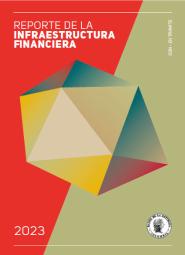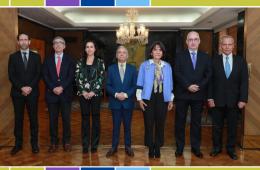Minutes of the Meeting of the Board of Directors of Banco de la República of January 30, 2015
A regular meeting of the Board of Directors of Banco de la República took place in the city of Bogotá, D.C., on January 30, 2015. In attendance were Mauricio Cárdenas Santamaría, Minister of Finance and Public Credit, José Darío Uribe Escobar, Governor of the Central Bank, and Board Members Carlos Gustavo Cano Sanz, Ana Fernanda Maiguashca Olano, Adolfo Meisel Roca, César Vallejo Mejía, and Juan Pablo Zárate Perdomo.
These minutes contain a summary of the outlook of Banco de la República's technical staff on the macroeconomic situation (section 1), followed by a review of the main discussion regarding policy alternatives considered by the Board of Directors (section 2).
A more detailed description of the macroeconomic situation prepared by the technical staff from the Central Bank is provided in the data section of the December 2014 edition of the Inflation Report, as well as in the statistical appendix.
1. MACROECONOMIC CONTEXT
- In the present report, oil prices continued to decrease and registered levels unobserved since 2009. The probability that a major portion of this descent be structural is high; therefore the forecasts on the price of oil lowered significantly versus the estimations produced a quarter before. Other products exported by Colombia such as coal and nickel also posted falls in their international prices.
- The risk premia of several emerging countries have increased, their currencies have depreciated, and the price of some financial assets has deteriorated. This behavior has been much more accentuated in oil-producing countries such as Colombia.
- This has taken place within a context of weak global economic activity, driven mainly by the economy of the USA. The euro zone continues with low growth of its GDP, while that of the main emerging countries continues to slow down or registers historically low increases. With this outlook, the technical staff reduced the average growth of our trade partners for 2015, a fact that reflects a weaker recovery than had been estimated in the previous quarterly report.
- In the USA, the long-term interest rates fell again, and it is likely that the first increase in the FED's benchmark rate takes place at the start of the second semester and that it continues gradually. Regarding the euro zone, the European Central Bank began its purchasing program of financial bonds, which will extend at least until September 2016.
- The fall in the prices of oil, which surpasses the reductions in the international prices of some food items imported by Colombia, will be reflected on a greater-than-expected descent in the country's terms of trade. Should these levels continue, the national income in 2015 would fall.
- The fall in the price of oil continues to affect the value of the country's exports. In November 2014, external sales fell, which is explained mainly by the lower prices of oil exported. Sales of the main agricultural products continued showing high increases, while exports of other sectors fell, although not as much as those of the mining sector.
- Given the aforesaid, for all of 2014 the most probable forecast of the current account deficit as a proportion to the GDP increased, reaching the higher limit of the range estimated a quarter before (5.0%). It is estimated that in 2015 the deficit and its financing be lower, partly as a result of an expected reduction in direct foreign investment (especially in oil), and by a less dynamic portfolio investment.
- As for the domestic context, the new data for the fourth quarter of 2014 suggest that domestic demand continued to be dynamic, and that the net exports would have subtracted more than was expected to the output. Considering this, the technical staff expects that economic growth for 2014 may be posting between 4.5% and 5.0%, with 4.8% as the most probable outcome.
- As for the labor market, with seasonally adjusted data, the unemployment rate to December continues to be low, with the highest occupation rate of the last 14 years, driven mainly by salaried employment.
- In December, annual growth of corporate credit has slowed down, a fact that is explained mainly by the lower pace in the increase of direct foreign credit. On the contrary, consumer credit showed a greater dynamism, and more than compensated the slow-down registered in mortgage loans. This has taken place together with relatively stable credit rates, which during the second semester of 2014 have only partially reflected the increase registered in the benchmark interest rate.
- For 2015, the technical staff reduced the range for the economic growth forecast to an interval between 2.0% and 4.0%, with 3.6% as the most probable figure. This more likely estimate considers a fall in the national income and lower foreign financing, which could generate a moderation in expenditure, especially due to a lower level of private investment.
- Nevertheless, it is important to mention that uncertainty regarding the aforementioned range is high and will depend on the size of the fall expected in the terms of trade, the cost and level of foreign financing, and the effect that the fall in the national income would have over the decisions of private and public expenditure. If the most likely growth forecasts take place, the output gap could be positive in 2014 and may become slightly negative in the present year (which had previously been estimated as positive).
- Regarding prices, inflation posted at 3.66% in December 2014, a number similar to the forecast by Banco de la República's technical staff, and which is 80 basic points (bp) above that of September. In the last quarter, the greater pace of increase in the prices of foods and regulated goods explained a great percentage of the acceleration of inflation. In the same period, the average of the four core inflation indicators increased 43 bp and posted at 3.06% in December.
- Inflation expectations of market analysts on a one year horizon as well as those derived from public debt bonds for longer terms increased and are above 3.0%.
- It is expected that the greater level of the exchange rate be passed-through to domestic prices, although the magnitude of said transmission depends on many factors, which makes it uncertain. In this context, given the accumulated depreciation until January of 2015, there is a risk that consumer inflation continues to increase this year. A high pass-through could affect expectations and have more persistent effects on inflation.
In all, domestic demand continues to be dynamic in a context close to the full use of the productive capacity. At the same time, inflation and its expectations are above 3.0%. This takes place in an environment of strong deterioration of the terms of trade, with high uncertainty regarding its future behavior. Global economic activity is recovering more slowly than was expected, and the evolution of the cost of financing is also uncertain. All these factors can impact the future behavior of aggregate demand.
2. DISCUSSION AND POLICY OPTIONS
The Board Members agree that Colombian economy will adjust to the fall in the terms of trade, growing less in 2015 and 2016 than in 2013 and 2014.
The dynamics of inflation in 2015 will mainly be affected by a lower economic growth and by the possible short-term effects of the depreciation of the peso on consumer inflation. Some Board Members consider that the effect of depreciation can initially take precedence over the low growth and transitorily deviate inflation from the target. As long as the expectations continue to be anchored to the mid-term target (3.0%), this effect on inflation would fade within the monetary policy horizon.
In turn, one of the members of the Board expects GDP to grow between 3.0% and 3.5%, with which the negative output gap would be greater than is expected by the technical staff and would have an even stronger mitigating effect over prices. In this context, it is appropriate for the monetary authority to continue keeping the benchmark interest rate unaltered.
With a countercyclical criterion, another Board Member considered necessary to contemplate scenarios with lower benchmark interest rates.
3. POLICY DECISION
The Board of Directors unanimously decided to keep the benchmark interest rate at 4.5%.
Bogotá, D. C.


















































